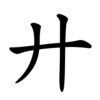廾
See also: 廿
| ||||||||
| ||||||||
Translingual
| Stroke order | |||
|---|---|---|---|
 | |||
Han character
廾 (radical 55, 廾+0, 3 strokes, cangjie input 十十 (JJ) or XX十十 (XXJJ), four-corner 44000, composition ⿻丿十 or ⿻𠂇丨)
- Kangxi radical #55, ⼶.
References
- KangXi: page 353, character 8
- Dai Kanwa Jiten: character 9583
- Dae Jaweon: page 668, character 7
- Hanyu Da Zidian: volume 1, page 513, character 11
- Unihan data for U+5EFE
Chinese
| simp. and trad. |
廾 | |
|---|---|---|
Glyph origin
| Historical forms of the character 廾 | |||
|---|---|---|---|
| Shang | Western Zhou | Shuowen Jiezi (compiled in Han) | Liushutong (compiled in Ming) |
| Oracle bone script | Bronze inscriptions | Small seal script | Transcribed ancient scripts |
 |
 |
 |
 |
- Etymology 1
Ideogrammic compound (會意) : 𠂇 (“left hand”) + 又 (“right hand”).
- Etymology 2
Variant of 廿.
Japanese
Korean
Vietnamese
Han character
廾 (trấp, trập, củng)
- This term needs a translation to English. Please help out and add a translation, then remove the text
{{rfdef}}.
References
This article is issued from
Wiktionary.
The text is licensed under Creative
Commons - Attribution - Sharealike.
Additional terms may apply for the media files.